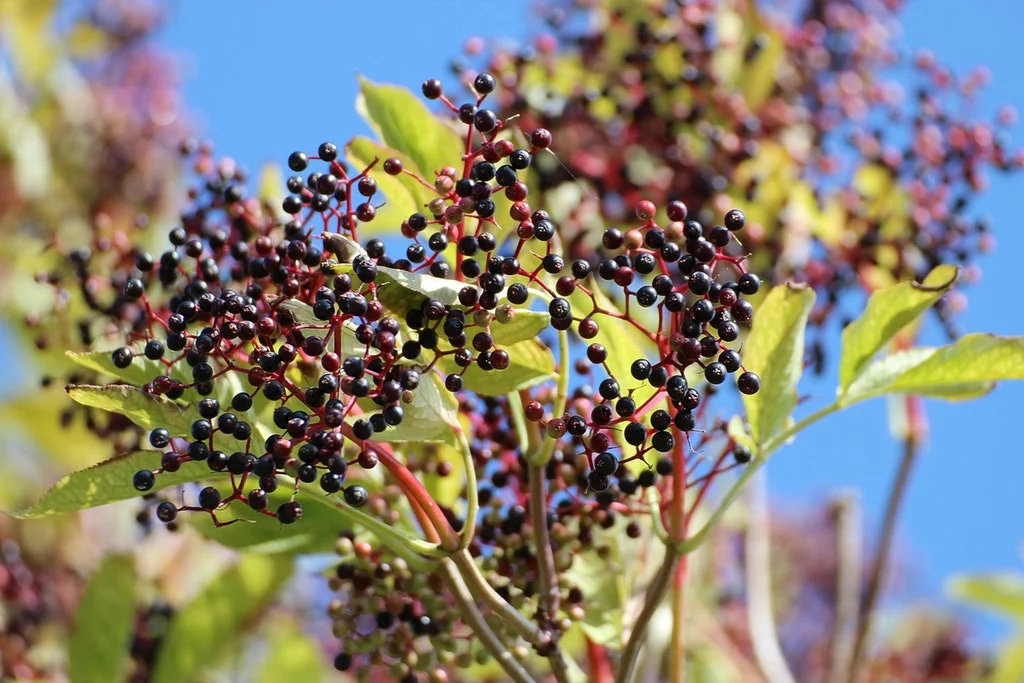Table of Contents
Do you want to try your hand at planting elderberries? Our short but complete tutorial below will teach you how to grow elderberries and how to take care of them so you can grow healthy plants.
The elderberry bush is native to Europe and North America where it has been grown and harvested for centuries.
Its uses have evolved over the years. In Europe, the hollowed stalk of the elderberry bush was once used to make smoking pipes, giving the alternative name "pipe bush" to the elderberry plant. An old myth even tells us that planting an elderberry bush near your kitchen will ward off diseases! From elder-flower face wash, to elderberry wine, there are many uses for this hardy plant.
Planting Elderberry
Photo Credit: Elder Blossom View
While the elderberry bush can tolerate a variety of soil conditions, this plant is not drought tolerant. It does best in loamy, well-drained soil and benefits from heavy fertilization. If you live in an area with sandy soil, you will have to add organic compost to your garden or pots to ensure good growth. Also, consider that elderberries are not self-pollinating, so two or more plants should be planted to ensure pollination.
After preparing the soil, plant elderberries in the early Spring when the last danger of frost has passed. Space the plants at least six feet apart, and give them plenty of water.
Caring for Elderberry Plants
Photo Credit: Little House on Pine
Cultivation of elderberry plants should be done often. Using wood chips as ground cover can help reduce unwanted weeds as well as help retain moisture.
When pulling weeds is necessary, take extra care to not disturb the roots of the elderberry plant. They are shallow so be careful.
Elderberries require nearly an inch of rainfall each week! If you don't have an inch of rainfall where you live in any given week (especially during the Summer months), watering will be necessary.
While elderberry plants usually do produce berries during their first year, they are generally not harvested until the third year of the plant's life. No pruning should be done during the first two years either. Allow the plant to mature on its own in order to ensure a strong and healthy stalk.
How to Fertilize Elderberry
Early Spring is the best time to fertilize your elderberry plants. Around 1/8 pound of ammonium nitrate is recommended for each year of the plant's life not to exceed one pound. If you prefer to use an application of 10-10-10, then apply 1/2 a pound for every year of the plant's life, not to exceed four pounds. Annual fertilization will ensure that you have bushels of plump, juicy berries each and every year!
Pruning can begin after the third year. In the early Spring, trim back any dead areas and shape the plant to your liking. Additional pruning should take place annually. Each year, be sure to prune away any stalks that are over four years old, as berries will grow most abundantly on stalks that are two and three years old.
When to Harvest Elderberries
After caring for your elderberry bushes for the first three years, it's finally harvest time!
Elderberry bushes explode with clusters of fragrant white flowers in late June. Some of these can be harvested to create a refreshing face-wash or a variety of medicinal applications. As the flowers die back, bunches of tiny berries will soon appear. If there are birds nearby, covering your plants with a netting will help ensure your crop stays safe!
Because of their size, elderberries can't be mechanically harvested. Berries for jams, jellies, pies or wine should be harvested at the peak of ripeness.
Begin checking the berries about mid-August. The ripe fruit will be heavy and tend to hang upside-down. Harvest each bunch, and then separate the berries from the cluster, storing them lightly covered in the refrigerator. Check the bushes every day until mid-September. Each elderberry bush can produce between 12 and 15 pounds of berries!
What to Use Elderberries for
Elderberry syrup for the flu, sinus pain, nerve pain, and a whole lot more.
Raw elderberries are bitter and rarely eaten. Recipes for elderberries range from easy jams and jellies to more involved medicinal applications. Elderberries have high quantities of phosphorus, potassium and vitamin C. They contain anti-inflammatory as well as anti-viral properties, and have been used to make insect repellent, cough syrup and anti-fungal sprays.
With its many uses, the elderberry bush isn't just a great ornamental choice for any garden. It's practically a must-have if you enjoy canning, baking or dabbling in home-made remedies! And because this plant freely suckers, as an older plant dies away, a sucker branch can easily be cultivated to take its place.
Your elderberry plants are a life-long investment. Happy growing and happy harvests!













